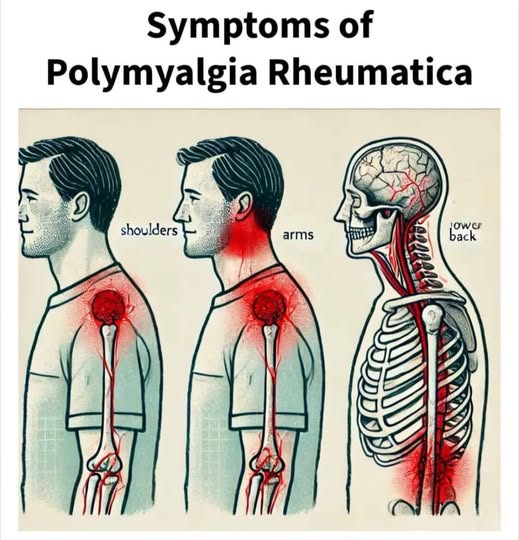🧠 Symptoms of Polymyalgia Rheumatica (PMR)
You might not realize you’re suffering from this condition, especially because its signs can often be mistaken for normal aging or other illnesses. Here’s how to recognize it and what you can do.

🔎 What Is Polymyalgia Rheumatica?
Polymyalgia Rheumatica (PMR) is an inflammatory disorder that causes muscle pain and stiffness, particularly in the shoulders, neck, and hips. It typically affects people over the age of 50, with symptoms appearing suddenly or gradually.
⚠️ Common Symptoms of PMR:
1. Muscle Pain and Stiffness
- Location: Usually in the shoulders, upper arms, neck, buttocks, or thighs
- Worse in the morning or after long periods of rest
- Makes it difficult to raise your arms or get out of bed
2. Limited Range of Motion
- Difficulty lifting your arms, getting dressed, or climbing stairs
- Movements feel “tight” and restricted
3. Fatigue and Low Energy
- Persistent tiredness even after rest
- Can lead to decreased daily activity
4. Mild Fever or Flu-like Symptoms
- Some people feel slightly feverish
- Achiness and general malaise
5. Unintended Weight Loss
- You may lose weight without trying, due to inflammation or decreased appetite
6. Depressed Mood or Irritability
- Ongoing pain and fatigue can take a toll on your mental health
7. Swelling or Tenderness
- Especially in the joints (hands, wrists, knees may feel puffy)
🩺 What Causes It?
The exact cause is unknown, but PMR is believed to involve autoimmune activity, where the body mistakenly attacks healthy tissue. It is sometimes associated with giant cell arteritis, a more serious condition involving blood vessels.
✅ How to Manage PMR:
1. Medication (Main Treatment)
- Low-dose corticosteroids like prednisone are the standard treatment
- Symptoms often improve dramatically within days of starting steroids
2. Regular Checkups
- Frequent visits to monitor inflammation and adjust treatment as needed
3. Gentle Exercise
- Stretching, walking, or swimming helps maintain joint flexibility and prevent stiffness
4. Healthy Diet
- Anti-inflammatory foods (fish, leafy greens, berries)
- Calcium and vitamin D to protect bones during steroid use
5. Rest and Stress Management
- Adequate sleep and relaxation techniques like yoga or meditation may help
📝 When to See a Doctor
If you have persistent pain and stiffness, especially if it’s worse in the morning and over age 50, consult your healthcare provider. Early diagnosis leads to faster relief and prevents complications.